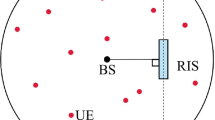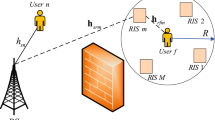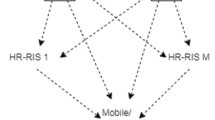Abstract
Reconfigurable intelligent surface (RIS) is envisioned to be a promising solution to enhance coverage and capacity of future wireless networks. With the deployment of multiple RISs, the optimal placement and topology are crucial issues that need to be addressed, which are significantly different from that of active BSs/relays. This paper considers a mmWave MIMO system aided by multiple RISs in a circular layout to observe the effect of RIS placement and power scaling law. The active and passive beamforming are configured to combine the signals coherently to improve the spectral efficiency (SE). To this end, we investigate the effect of quantization error on the SE and derive an upper bound. It indicates that the SE loss is only affected by the number of quantization bits and numerical results show that 5-bit quantizer is sufficient to ensure an acceptable SE degradation. Furthermore, we evaluate the performance of the system by formulating the tight upper bounds on the average ergodic spectral efficiency and propose three effective schemes for RIS selection. Our simulation results verify the derivations and validate that the performance of deploying the RISs close to BS is significantly better than that of deploying the RISs randomly in the cell.










Similar content being viewed by others
References
Shafi, M., et al. (2017). 5G: a tutorial overview of standards, trials, challenges, deployment, and practice. IEEE Journal on Selected Areas in Communications, 35(6), 1201–1221.
Saad, W., Bennis, M., & Chen, M. (2020). A vision of 6G wireless systems: applications, trends, technologies, and open research problems. IEEE Network, 34(3), 134–142.
Boccardi, F., Heath, R. W., Lozano, A., Marzetta, T. L., & Popovski, P. (2014). Five disruptive technology directions for 5G. IEEE Communications Magazine, 52(2), 74–80.
Wu, Q., & Zhang, R. (2020). Towards smart and reconfigurable environment: intelligent reflecting surface aided wireless network. IEEE Communications Magazine, 58(1), 106–112.
Basar, E., Di Renzo, M., De Rosny, J., Debbah, M., Alouini, M.-S., & Zhang, R. (2019). Wireless communications through reconfigurable intelligent surfaces. IEEE Access, 7, 116753–116773.
Di Renzo, M., Zappone, A., Debbah, M., Alouini, M.-S., Yuen, C., de Rosny, J., & Tretyakov, S. (2020). Smart radio environment empowered by reconfigurable intelligent surfaces: how it works, state of research, and the road ahead. IEEE Journal on Selected Areas in Communications, 38(11), 2450–2525.
Wu, Q., & Zhang, R. (2019). Intelligent reflecting surface enhanced wireless network via joint active and passive beamforming. IEEE Transactions on Wireless Communications, 18(11), 5394–5409.
Wu, Q., & Zhang, R. (2019). Beamforming optimization for intelligent reflecting surface with discrete phase shifts. In: Proceedings of IEEE International Conference on Acoustics, Speech, and Signal Processing (ICASSP) (pp. 7830–7833). Brighton, UK.
Huang, C., Zappone, A., Alexandropoulos, G. C., Debbah, M., & Yuen, C. (2019). Reconfigurable intelligent surfaces for energy efficiency in wireless communication. IEEE Transactions on Wireless Communications, 18(8), 4157–4170.
Guo, H., Liang, Y. -C., Chen, J., & Larsson, E. G. (2019). Weighted sum-rate maximization for intelligent reflecting surface enhanced wireless networks. In Proceedings of IEEE Global Communications Conference (GLOBECOM) (pp. 1–6).
Mishra, D., & Johansson, H. (2019). Channel estimation and low-complexity beamforming design for passive intelligent surface assisted MISO wireless energy transfer. In Proceedings of IEEE International Conference on Acoustics, Speech and Signal Processing (ICASSP’19) (pp. 4659-4663), Brighton, UK.
He, Z., & Yuan, X. (2020). Cascaded channel estimation for large intelligent metasurface assisted massive MIMO. IEEE Wireless Communications Letter, 9(2), 210–214.
Wang, P., Fang, J., Duan, H., & Li, H. (2020). Compressed channel estimation for intelligent reflecting surface-assisted millimeter wave systems. IEEE Signal Processing Letters, 27, 905–909.
Taha, A., Alrabeiah, M., & Alkhateeb, A. (2021). Enabling large intelligent surfaces with compressive sensing and deep learning. IEEE Access, 9, 44304–44321.
Elbir, A. M., Papazafeiropoulos, A., Kourtessis, P., & Chatzinotas, S. (2020). Deep channel learning for large intelligent surfaces aided mm-Wave massive MIMO systems. IEEE Wireless Communications Letters, 9(9), 1447–1451.
Han, Y., Zhang, S., Duan, L., & Zhang, R. (2020). Cooperative double-IRS aided communication: Beamforming design and power scaling. IEEE Wireless Communications Letters, 9(8), 1206–1210.
Wang, P., Fang, J., Dai, L., & Li, H. (2021). Joint transceiver and large intelligent surface design for massive MIMO mmWave systems. IEEE Transactions on Wireless Communications, 20(2), 1052–1064.
Zheng, B., You, C., & Zhang, R. (2021). Double-IRS assisted multi-user MIMO: cooperative passive beamforming design. IEEE Transactions on Wireless Communications, 20(7), 4513–4526.
Wu, Q., & Zhang, R. (2020). Joint active and passive beamforming optimization for intelligent reflecting surface assisted SWIPT under QoS constraints. IEEE Journal on Selected Areas in Communications, 38(8), 1735–1748.
Wang, P., Fang, J., Yuan, X., Chen, Z., & Li, H. (2020) Intelligent reflecting surface-assisted millimeter wave communications: Joint active and passive precoding design. IEEE Transactions on Vehicular Technology (early access article).
Zhang & Dai, L. (2021) A joint precoding framework for wideband reconfigurable intelligent surface-aided cell-free network. IEEE Transactions on Signal Processing, 69, 4085–4101.
You, C., Zheng, B., & Zhang, R. (2021). Wireless communication via double IRS: channel estimation and passive beamforming designs. IEEE Wireless Communications Letters, 10(2), 431–435.
Lyu, J., & Zhang, R. (2020). Spatial throughput characterization for intelligent reflecting surface aided multiuser system. IEEE Wireless Communications Letters, 9(6), 834–838.
Park, E., Lee, S.-R., & Lee, I. (2012). Antenna placement optimization for distributed antenna systems. IEEE Transactions on Wireless Communications, 11(7), 2468–2477.
Firouzabadi, S., & Goldsmith, A. (2011) Optimal placement of distributed antennas in cellular systems. In Proceedings of IEEE SPAWC (461–465).
Li, J., Yue, D., & Sun, Y. (2018). Performance analysis of millimeter wave massive MIMO systems in centralized and distributed schemes. IEEE Access, 6, 75482–75494.
Alkhateeb, A., Leus, G., & Heath, R. W. (2015). Limited feedback hybrid precoding for multi-user millimeter wave systems. IEEE Transactions on Wireless Communications, 14(11), 6481–6494.
özdogan, Ö., Björnson, E., & Larsson, E. G. (2020). Intelligent reflecting surfaces: physics, propagation, and pathloss modeling. IEEE Wireless Communications Letters, 9(5), 581–585.
Ayach, O. E., Heath, R. W., Abu-Surra, S., Rajagopal, S., & Pi, Z. (2012). The capacity optimality of beam steering in large millimeter wave MIMO systems. In Proceedings of IEEE SPAWC (pp. 100–104).
Yue, D.-W., Nguyen, H. H., & Sun, Y. (2020). mmWave doubly-massive-MIMO communications enhanced with an intelligent reflecting surface: asymptotic analysis. IEEE Access, 8, 183774–183786.
David, H. A., & Nagaraja, H. N. (2003). Order statistics (3rd ed.). Wiley.
Acknowledgements
This work was supported in part by the Cultivation Program for the Excellent Doctoral Dissertation of Dalian Maritime University under Grant 0034012306; in part by the National Natural Science Foundation of China under Grant 62301108 and Grant 61971081; in part by Basic Research Projects of Liaoning Provincial Department of Education under Grant JYTMS20230176; and in part by the Open Research Program of State Key Laboratory of Millimeter Waves, Southeast University, under Grant K202208.
Author information
Authors and Affiliations
Corresponding author
Additional information
Publisher's Note
Springer Nature remains neutral with regard to jurisdictional claims in published maps and institutional affiliations.
Appendices
Appendix A
We denote the quantization error on the phase of each n-th element as \({\delta _{i,n}}\) which satisfies \(- \frac{{2\pi }}{{{2^B} + 1}} \le {\delta _{i,n}} \le \frac{{2\pi }}{{{2^B} + 1}}\). Define
The baseband equivalent channel of the UE k can be written as
Since \(B \ge 1\), we have
Then the SE of the UE k in (3) achieved by using finite-resolution beamforming can be rewritten as
where
Then the SE loss can be calculated as
where \(\left( a \right)\) is from the fact that \(\log \left( {\frac{{1 + a}}{{1 + b}}} \right) \le \log \left( {\frac{a}{b}} \right)\) for any positive numbers a and b.
Consequently, we can get the upper bound in (13).
Appendix B
By using (19), we have
where (a) makes use of the binomial theorem \({\left( {a + b} \right) ^n} = \sum \limits _{k = 0}^n {{\text{C}}_n^k{a^{n - k}}{b^k}}\) where the coefficient \({\text{C}}_n^k = \left( {\begin{matrix} n\\ k \end{matrix}} \right) = \frac{{n!}}{{k!\left( {n - k} \right) !}}\), and (b) results from \(\int \limits _0^\infty {{e^{ - tx}}xdx = {t^{ - 2}}}\). In the same way, we can deduce that \({\mathbb {E}} \left\{ {{{\left| {\alpha _{2,k,{q}}^{{\bar{l}}}} \right| }^2}} \right\} = \sum \limits _{t = 1}^{{L_{2,k,{q}}}} {\left( {\begin{matrix} {{L_{2,k,{q}}}}\\ t\\ \end{matrix}} \right) } {\left( { - 1} \right) ^{t - 1}}{t^{ - 1}}\).
We introduce the new variables defined as
where \(\varDelta\) is used to replace subscripts in \({{L_{1,{q}}}}\) and \({{L_{2,k,{q}}}}\).
When \(5 \le L \le 10\), the variables \({\xi _\varDelta }\) can be approximated by \({\xi _\varDelta } \approx 0.0106L_\varDelta ^2 - 0.185{L_\varDelta } + 1.116\). With \({L_\varDelta } \sim DU\left[ {1,L} \right]\), \(L_\varDelta\) has the maximum value when \({L_\varDelta }=1\), i.e., \({{\xi _\varDelta }} \le 0.9416\).
With the assumption \(\theta _{{\mathop {\text{inter}}} }^{{q}} \sim U\left[ {{\vartheta _a},{\vartheta _b}} \right]\) and \(0 \le {\vartheta _a} \le {\vartheta _b} \le \pi\), we have
By using (14), we have
In addition, according to \({\mathbb {E}}\left( {AB} \right) ={\mathbb {E}} \left( A \right) {\mathbb {E}}\left( B \right)\) and \(\sum \limits _{q = 1}^Q {{m_{k,q}}} = 1\), we have
Substituting (42) into (18), the upper bound expression on the average ESE of the cell can be calculated as (20).
Appendix C
According to the definite integral formula
we can obtain
Substituting (44) and (45) into (23), the upper bound in (24) can be obtained.
Rights and permissions
Springer Nature or its licensor (e.g. a society or other partner) holds exclusive rights to this article under a publishing agreement with the author(s) or other rightsholder(s); author self-archiving of the accepted manuscript version of this article is solely governed by the terms of such publishing agreement and applicable law.
About this article
Cite this article
Li, GH., Yue, DW. & Jin, SN. Performance analysis of multiple RISs aided multi-user mmWave MIMO systems. Wireless Netw 30, 1911–1924 (2024). https://doi.org/10.1007/s11276-023-03631-y
Accepted:
Published:
Issue Date:
DOI: https://doi.org/10.1007/s11276-023-03631-y




